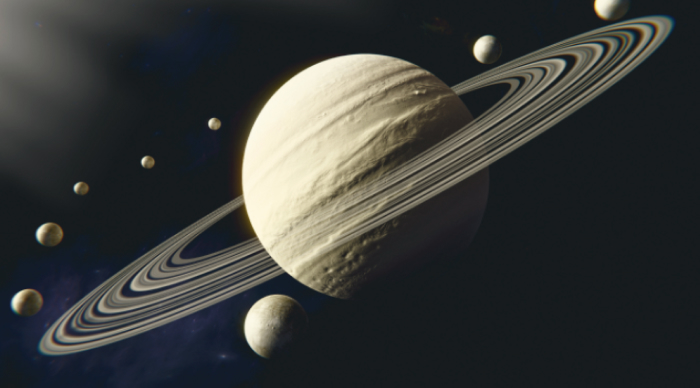“The internal structure of the planet Saturn”

A second-year student in the Astronomy program at Termiz State University
Annotation:
This article explores the internal structure of Saturn, the second-largest planet in the Solar System. It examines the composition and characteristics of its core, metallic hydrogen layer, molecular hydrogen envelope, and atmospheric features. Special attention is given to the processes influencing Saturn’s internal heat, magnetic field, and rotation. The study also discusses current scientific models and data obtained from space missions, which contribute to a deeper understanding of the planet’s formation and evolution
Kalid so’z:
Keywords: Saturn, internal structure, core composition, metallic hydrogen, planetary science, gas giants, atmosphere, magnetic field.
The Internal Structure of Saturn
Saturn is the second-largest planet in the Solar System, with a diameter of approximately 120,536 km and a mass about 95 times that of Earth. It belongs to the class of gas giants.
1. Core
Saturn is believed to have a solid core at its center.
Estimated diameter: around 25,000 km.
Composition: iron, nickel, oxygen, silicates, and ice mixtures.
Estimated temperature: ~11,700 °C.
2. Metallic Hydrogen Layer
Located above the core.
Under extreme pressure and temperature, hydrogen takes on a metallic form. The planet’s strong magnetic field is generated by movements within this layer.
3. Molecular Hydrogen Layer
Composed mainly of molecular hydrogen mixed with helium.
Temperature increases with depth.
4. Atmosphere
Main composition: 96% hydrogen, 3% helium, with traces of methane, ammonia, and other gases.
Cloud layers are divided into three main zones from top to bottom:
Ammonia ice clouds Ammonium hydrosulfide clouds
Water ice clouds
5. Heat Source
Saturn emits about 2.5 times more heat than it receives from the Sun.
This is due to the Kelvin–Helmholtz process (gravitational compression) and helium rain.
6. Research
Voyager 1 and Voyager 2 (1979–1981) provided the first comprehensive data about Saturn.
Cassini–Huygens (2004–2017) gathered highly detailed information about Saturn, its rings, and moons.

Saturn or Zuhal (Arabic) — one of the nine major planets of the Solar System; the sixth planet from the Sun in terms of distance. Its astronomical symbol is ♄. The average distance from the Sun is 9.58 astronomical units (1,429.3 million km). In terms of size, it ranks second after Jupiter. Due to its orbital eccentricity of 0.056, this distance decreases at perihelion and increases at aphelion. Saturn completes one full revolution around the Sun in 29 years and 167 days. Its rotation period at the equator is 10 hours 14.5 minutes, increasing toward the poles, as on Jupiter. Saturn’s average radius is 58,000 km, and at the equator it is close to 60,000 km. Its density is 0.72 g/cm³ (about 0.13 of Earth’s density), and its mass is 5.681 × 10²⁷ g (95.28 times that of Earth). It is composed mainly of hydrogen and helium. The inclination of Saturn’s equator to its orbital plane is 26°45′. Elongated dark belts along the equator and white spots can be observed on its surface.
Spectroscopic studies have shown that Saturn’s atmosphere is mainly composed of hydrogen (H₂) and methane (CH₄); later, acetylene (C₂H₂) and ethane (C₂H₆) were also discovered. Infrared observations indicate a temperature of about 95 K. Saturn emits regular radio waves and has its own magnetic field. Even at such low temperatures, methane and ammonia remain in a gaseous state in its atmosphere. Saturn was first observed by Galileo in 1610.
Saturn’s most remarkable feature is its ring system, which lies in the plane of its equator. The rings are mainly composed of three distinct concentric parts: the innermost S ring, the middle V ring, and the outer A ring. All rings are almost transparent, allowing the stars behind them to be seen. The gap between the A and V rings is called the Cassini Division. The rings are a few kilometers thick, have a diameter of about 250,000 km, and are roughly 100 million years old. As early as the beginning of the 20th century, it was established that the rings are not solid, but consist of numerous solid particles orbiting Saturn according to Kepler’s laws. Their infrared spectra are very similar to those of ice and frost.
Saturn has 22 known natural satellites. The largest among them are Mimas, Enceladus, Tethys, Dione, Rhea, Titan, Hyperion, Iapetus, Phoebe, and Janus. Titan, with a diameter of 4,850 km, is one of the largest satellites in the Solar System (larger than the Moon). Titan possesses an atmosphere composed of methane and hydrogen. Of Saturn’s moons, only Phoebe moves in a retrograde orbit relative to the others.
Saturn is the sixth planet from the Sun and the second largest in the Solar System. Along with Jupiter, Uranus, and Neptune, it belongs to the class of gas giants. It is named after the ancient Roman god Saturnus (Unicode: ♄).
Saturn is composed mainly of hydrogen, with small amounts of helium and other elements. The region near its core consists of rock and ice, surrounded by metallic hydrogen. Its outer atmosphere is generally uniform in appearance, although persistent storms sometimes occur. Winds on Saturn can reach speeds of up to 1,800 km/h, which is much faster than those on Jupiter. Saturn has a magnetosphere weaker than Earth’s but stronger than Jupiter’s.
Saturn is famous for its rings, which are made primarily of ice particles mixed with dust. Many moons orbit the planet — about sixty are currently known. Titan, Saturn’s largest moon and the second largest in the Solar System (after Ganymede), is larger than Mercury and is the only natural satellite in the Solar System known to have a dense atmosphere.
Foydalanilgan adabiyotlar:
1. Mamadazimov, M., and A. B. Narbayev. “An e-learning guide for students of the 11th grade of secondary education and secondary special, vocational education institutions.” (2018).
2. Bahramovich N. A. STRUCTURE AND DIDACTICAL POSSIBILITIES OF THE ELECTRONIC TRAINING MANUAL ON ASTRONOMY DEVELOPED FOR PUPILS OF THE 11TH GRADES OF SECONDARY SCHOOLS BASED ON MEDIA EDUCATION //Archive of Conferences. – 2020. – Т. 5. – №. 1. – С. 40-42.
3. Narbaev A. B. Advantages of using media technology in astronomy teaching //Journal of Innovations in Pedagogy and Psychology. – №. 2. 4. Narbaev A. B. METHODS OF USING MEDIA EDUCATION AND TELECOMMUNICATION TECHNOLOGIES IN TEACHING THE TOPIC” VISUAL MOTION OF THE SUN AND STARS” //Central Asian Problems of Modern Science and Education. – 2020. – Т. 2020. – №. 1. – С. 119-125.
4. Ksanfomaliti L. V., Planeti otkritie zanovo, M., 1978; Kulikovskiy P. G., Spravochnik lyubitelya astronomii, M., 1971; Silkin B.I., V mire mnojestva lun, M., 1982; Mamatazimov M., Quyosh sistemasi haqida ocherklar, T., 1984
5. OʻzME. Birinchi jild. Toshkent, 2000-yil

Pingback: Synchronized Chaos September 2025: The Stream of Life, Love, and Death | SYNCHRONIZED CHAOS